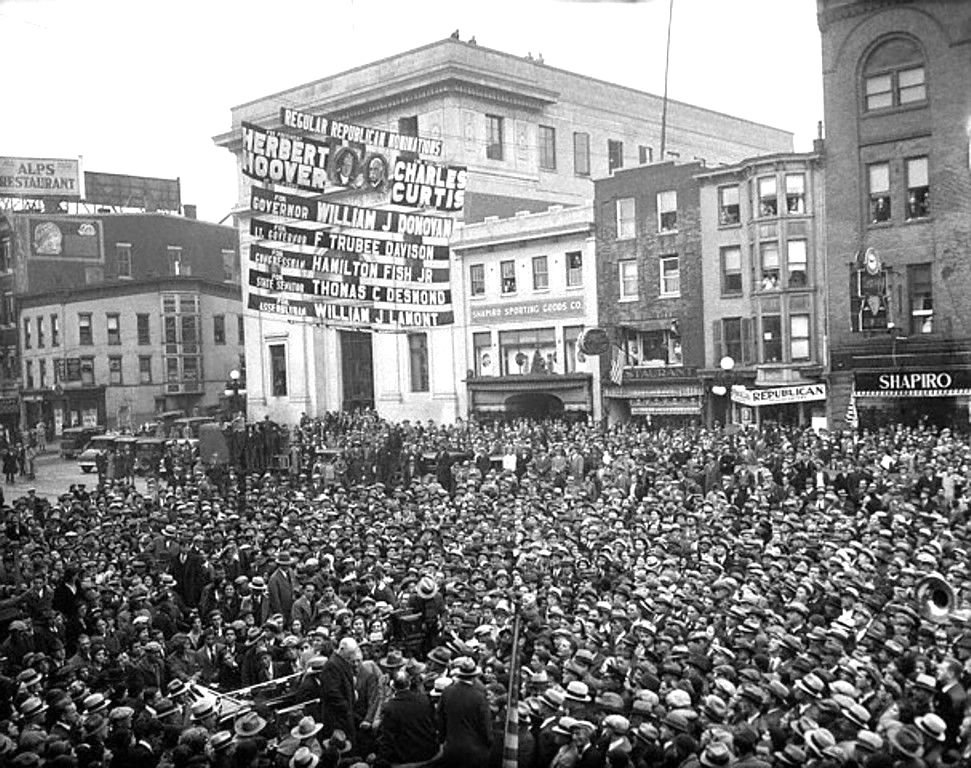
A large crowd gathers on Broadway between Liberty and Grand Streets to hear Governor Franklin Roosevelt give a campaign speech seeking the U.S. Presidency.
By Mary McTamaney
Recently, the Facebook site, Remembering Newburgh NY, posted a photo of a large crowd gathered on lower Broadway. Stretched across the wide avenue is a multi-tiered banner advertising “Regular Republican Nominations” for the state offices of Governor, Lieutenant Governor, U.S. Congressman, State Senator and State Assemblyman.
The banner is an expensive, professional one and includes the giant photo images of the candidates for U.S. President and Vice-President leading the Republican ticket: Herbert Hoover and Charles Curtis. It is anchored on ropes attached to City Hall and to the Academy of Music building on the opposite corner. The year was 1932 and the Newburghers who packed into Broadway under that banner were not there to cheer for the Republican candidates whose names flew overhead. That fall day, the object of the crowd’s attention was the man who hoped to unseat those banner candidates, Dutchess County resident, Franklin Delano Roosevelt. At the time, he was the governor of New York. It is hard in the old photo to see him, but his open touring car is backed into the curb outside City Hall and a cameraman is positioned in front of him in the roadway.
My father was there that day. A recent NFA graduate, dad was not yet eligible to vote but was attracted to all the commotion. He told me that, as a young man, he witnessed FDR campaigning twice more in Newburgh in that exact spot, in 1936 and 1940. Newburgh was always a staunchly Republican city so each fall, it was festooned with mostly Republican election signs. Still, Franklin Roosevelt chose City Hall and the busy theater district to make his campaign address. After he won in 1932, he considered Newburgh and its big opposition banners good luck. He would have his driver park under the Republican banners so they would appear in each photo. My dad heard him address one crowd in 1940 and say “I see my omen of good fortune flying overhead!”
Republican Party headquarters operated out of 86 Broadway in 1932 as this old photo shows. That address had been a confectionery store and had recently closed, perhaps because of the spread of the Great Depression. It would later become the Charles Men Shop where a more modern steel façade would change the upper three stories of bay windows where apartment dwellers can be seen watching the big crowd gather. Neighboring buildings seen in this photo held their own for some time: The Newburgh Savings Bank at the corner of Liberty Street, Shapiro Sporting Goods (later Conover’s) and Hahn’s Restaurant. Shapiro Jeweler’s occupied the western shop on the ground floor of the Academy of Music. When that massive 19th century hall was demolished in 1957 to make way for parking, that jewelry store moved west along Broadway.
What struck me about the image of FDR’s 1932 rally, besides the large crowd filling Broadway, was the lack of campaign “gear.” People (men and women) are wearing their own hats, not political caps. They are not carrying signs. I can’t even detect campaign buttons on their clothing. They have brought their ears to listen to what would be said. The Great Depression had begun. Americans were scared. They needed to hear, and come to believe, someone who laid out a path for a better future. Lots of the Newburghers in that crowd probably did vote for Herbert Hoover and Charles Curtis and the rest of the candidates whose names floated over Broadway. History tells us that Franklin Roosevelt won the presidency that November. I looked a bit deeper to see what became of those other Republican men who sought office in 1932. I was surprised. Decorated World War I veteran, William Donovan, who wanted to be New York Governor, was appointed by FDR to run the OSS (Office of Strategic Services) when America entered World War II. F. Trubee Davidson, also a WWI flying ace pilot, became Assistant Secretary of War under FDR (and later President of the American Museum of Natural History).
Rivals had common goals and beliefs and joined forces when they were needed.